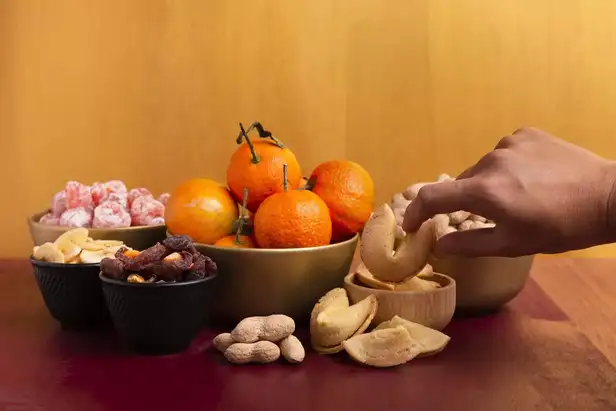
Navratri Fasting: A Balance of Spirituality and Wellness
Navratri, the nine-day festival dedicated to Goddess Durga, is not just a time of devotion but also a period of discipline, purification, and self-control. Fasting is an integral part of this celebration, connecting the body with the spirit. While many people observe fasts purely as a religious practice, it also provides an excellent opportunity to detoxify, improve dietary habits, and boost overall well-being. However, to make the most of this spiritual and health-driven journey, it is essential to choose the right foods, maintain hydration, and practice mindful eating.
Below are some key ways to ensure your Navratri fast remains both nourishing and spiritually uplifting.

1. Choosing the Right Foods for Navratri Fasting
The foundation of a healthy fast lies in mindful food choices. Traditionally, vrat-friendly ingredients are chosen for their easy digestibility and nutritional value.

- Sabudana (tapioca pearls): A popular fasting food that provides quick energy. When paired with peanuts or curd, it also becomes a good source of protein, helping you stay fuller for longer hours.
- Kuttu (buckwheat) and Singhara (water chestnut flour): Gluten-free alternatives to regular grains. These are rich in fiber, support digestion, and provide sustained energy. Popular dishes include kuttu ki puri, singhara paratha, or chilla.
- Amaranth (rajgira): Packed with protein, calcium, and iron, rajgira helps in building stamina and strengthening immunity during fasting.
- Fresh fruits and dry fruits: These are natural sources of carbohydrates, vitamins, and healthy fats. Seasonal fruits not only provide energy but also help maintain hydration levels.
- Dairy products: Curd, paneer, and milk are high in protein and keep muscles strong while supporting immunity.
By carefully combining these wholesome ingredients, you can strike a balance between religious devotion and nutritional wellness.
2. Staying Hydrated and Energized
One of the biggest challenges during fasting is avoiding dehydration and fatigue. Reduced meal frequency and long prayer hours can drain energy levels, making hydration extremely important.

- Water: Drink small sips throughout the day to avoid headaches, weakness, or dizziness.
- Coconut water: Rich in natural electrolytes like potassium and magnesium, it helps replenish minerals lost through sweating, especially useful for Garba or dandiya nights.
- Buttermilk: A cooling and probiotic-rich drink that aids digestion, reduces acidity, and provides quick refreshment.
- Herbal teas: Infusions of tulsi, ginger, or lemon can strengthen immunity and improve metabolism during the fasting period.
Avoid caffeinated and sugary drinks as they can cause dehydration and sudden energy crashes. Instead, focus on natural fluids that rejuvenate both body and spirit.
3. Balancing Nutrition in Your Meals
Fasting should not mean compromising on nutrition. With smart planning, you can keep your meals balanced and energy levels steady.

- Proteins: Paneer, yogurt, nuts, seeds, and rajgira are excellent protein sources to maintain muscle health and reduce hunger pangs.
- Complex carbohydrates: Kuttu, singhara, and sweet potatoes provide slow-releasing energy, unlike simple carbs that spike blood sugar levels.
- Healthy fats: Almonds, walnuts, peanuts, and a little ghee or coconut oil can keep you satiated and provide essential fatty acids.
- Fruits and vegetables: Fresh produce adds fiber, antioxidants, and essential vitamins, which improve digestion and immunity.
Instead of eating two heavy meals, try having smaller, balanced meals every 3–4 hours. This not only prevents overeating but also keeps energy levels consistent throughout the day.
4. Avoiding Common Fasting Mistakes
Many devotees unintentionally turn Navratri fasting into an unhealthy routine by indulging in oily or sugary foods. While these may be labeled as “vrat-friendly,” they often defeat the true purpose of fasting.
- Limit fried foods: Snacks like sabudana vada, potato chips, and kuttu pakoras may taste delicious but can cause acidity, bloating, and weight gain if eaten excessively.
- Be mindful of sweets: Traditional desserts made with sugar or artificial sweeteners give instant energy but can lead to cravings and sluggishness. Instead, opt for natural sweeteners like dates, figs, or a small portion of jaggery.
- Avoid packaged foods: Ready-to-eat fasting items may contain preservatives, excess salt, or hidden sugars that harm the body rather than cleanse it.
- Choose lighter cooking methods: Roasting, steaming, and pan-grilling are healthier than deep frying. Replace fried snacks with roasted makhana, fruit bowls, or yogurt smoothies.

By steering clear of these common mistakes, you ensure that fasting truly fulfills its goal of cleansing and rejuvenating the body.
5. The Spiritual and Holistic Essence of Navratri Fasting
At its core, Navratri fasting is more than just dietary restrictions—it is about discipline, mindfulness, and spiritual awakening. When you choose natural, sattvic (pure) foods, you align your body with the spirit of devotion. The process not only purifies the system but also creates a sense of lightness, positivity, and clarity of thought.
When done with balance, fasting offers:
- Physical detoxification
- Increased mental focus
- Spiritual upliftment
- A sense of harmony between body and soul
Final Thoughts
Navratri fasting is most beneficial when approached with awareness and balance. By selecting nutrient-rich foods, staying hydrated, eating smaller frequent meals, and avoiding heavy or processed snacks, you can make the fasting period both meaningful and health-enhancing.
This sacred time is not just about abstaining from food but about embracing purity, discipline, and rejuvenation. When observed mindfully, Navratri fasting brings together the best of health and spirituality—leaving you feeling refreshed, energized, and deeply connected to your inner self.
For the Latest Jobs Notifications: Click Here
Join With Us On WhatsApp: Click Here
Join With Us On LinkedIn: Click Here
Free Python Learning: Click Here